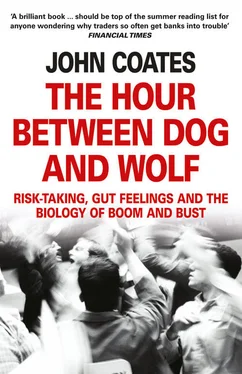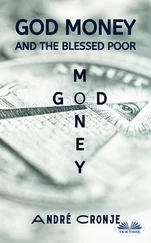I begin by looking at the physiology that produces our risk-taking, filling in the background story for what follows. I then show, through a story set on a trading floor, how this physiology can mix with lax risk-management systems and a bonus system that rewards excessive gambling to produce a volatile and explosive bank. We watch as nature and nurture conspire to produce an awful train wreck, leaving behind mangled careers, damaged bodies and a devastated financial system. We then linger in the wreckage and observe the resulting fatigue and chronic stress, two medical conditions that blight the workplace. Finally we look at some tentative yet hopeful research into the physiology of toughness, in other words training regimes designed by sports scientists and stress physiologists to immunise our bodies against an overactive stress response. Such training could help calm the unstable physiology of risk-takers.
1 : The Biology of a Market Bubble 2 : Thinking with Your Body PART II : GUT THINKING 3 : The Speed of Thought 4 : Gut Feelings PART III : SEASONS OF THE MARKET 5 : The Thrill of the Search 6 : The Fuel of Exuberance 7 : Stress Response on Wall Street PART IV : RESILIENCE 8 : Toughness 9 : From Molecule to Market Acknowledgements Notes Further Reading Index Copyright About the Publisher Конец ознакомительного фрагмента. Текст предоставлен ООО «ЛитРес». Прочитайте эту книгу целиком, купив полную легальную версию на ЛитРес. Безопасно оплатить книгу можно банковской картой Visa, MasterCard, Maestro, со счета мобильного телефона, с платежного терминала, в салоне МТС или Связной, через PayPal, WebMoney, Яндекс.Деньги, QIWI Кошелек, бонусными картами или другим удобным Вам способом.
THE FEELING OF A BUBBLE
My interest in the biological side of the financial markets dates back to the 1990s. I was then working on Wall Street, trading derivatives for Goldman Sachs, then Merrill Lynch, and finally running a desk for Deutsche Bank. This was a fascinating time to trade the markets, because New York, and indeed America as a whole, was caught up in the dot.com bubble. And what a bubble that was. The markets had not seen anything quite like it since the great bull market of the 1920s. In 1991 the Nasdaq (the electronic stock exchange where many new-tech ventures are listed) traded below 600, and had meandered around that level for a few years. It then began a gradual yet persistent bull run, reaching a level of 2,000 in 1998. The Nasdaq’s rise was checked for a year or so by the Asian Financial Crisis, which reined it back about 500 points, but then the market recovered and took to the skies. In little more than a year and a half the Nasdaq shot up from 1,500 to a peak just over 5,000, for a total return in excess of 300 per cent.
The rally was almost unprecedented in its speed and magnitude. It was completely unprecedented in the paucity of hard financial data supporting the dot.com and high-tech ventures powering the bull run. In fact, so large was the gap between stock prices and the underlying fundamentals that many legendary investors, betting unsuccessfully against the trend, retired from Wall Street in disgust. Julian Robertson, for instance, founder of the hedge fund Tiger Capital, threw in the towel, saying in effect that the market may have gone crazy but he had not. Robertson and others were right that the market was due for a dreadful day of reckoning, but they also fully understood a point made by the great economist John Maynard Keynes back in the 1930s: that the markets could remain irrational longer than they, the investors, could remain solvent. So Robertson retired from the field, his reputation and capital largely intact. Then, early in 2000, the Nasdaq collapsed, giving back over 3,000 points in little more than a year, eventually bottoming out at the 1,000 level where it had begun a few short years before. Volatility of this magnitude normally makes a few people rich, but I know of no one who made money calling the top of this market’s explosive trajectory.
Besides the scale of the run-up and subsequent crash, another feature of the Bubble was noteworthy, and reminiscent of the 1920s, at least the 1920s I knew from novels, black-and-white movies and grainy documentaries – that was how its energy and excitement overflowed the stock exchange, permeated the culture and intoxicated people. For the fact is, while they last, bubbles are fun; and the widespread silliness attending them is often remembered with a certain amount of humour and fondness. I imagine anyone who lived through the bull market of the Roaring Twenties retained an abiding nostalgia for that heroic and madcap time, when futuristic technology, blithe spirits and easy wealth seemed to herald a new era of boundless possibility. Of course, life in its aftermath must have been even more formative, and those born and raised during the Great Depression are said to carry, even into old age, what the historian Caroline Bird calls an ‘invisible scar’, a pathological distrust of banks and stock markets, and a morbid fear of unemployment.
My recollections of the 1990s are of a decade every bit as hopeful and every bit as screwball as the 1920s. During the nineties we were entertained by middle-aged CEOs in black poloneck sweaters trying to ‘think outside the box’; by kids in their twenties wearing toques and yellow sunglasses, backed by apparently limitless amounts of capital, throwing lavish parties in midtown lofts and talking wacky internet schemes few of us could understand – and even fewer questioned. To do so meant you ‘just didn’t get it’, one of the worst insults of the time, indicating that you were a dinosaur incapable of lateral thought. One thing I definitely didn’t get was how the internet was supposed to overcome the constraints of time and space. Sure, ordering online was easy, but then delivery took place in the real world of rising oil prices and road congestion. The internet company that made the most heroic attempt to defy this brute fact was Kozmo.com, a New York-based start-up that promised free delivery within Manhattan and about a dozen other cities within an hour. The people who paid the price for this act of folly, besides the investors, were the scores of bicycle messengers breathlessly running red lights to meet a deadline. You would see groups of these haggard youngsters outside coffee bars (with appropriate names like Jet Fuel) catching their breath. Not surprisingly the company went bankrupt, leaving behind a question asked about this and countless similar ventures: what on earth were the investors thinking?
Perhaps the right question should have been, were they thinking at all? Were investors engaged in a rational assessment of information, as many economists might – and did – argue? If not, then were they perhaps engaged in a different form of reasoning, something closer to a game theoretic calculation: ‘I know this thing is a bubble,’ they may have schemed, ‘but I’ll buy on the way up and then sell before everyone else.’ Yet when talking to people who were investing their savings in newly listed internet shares I found little evidence for either of these thought processes. Most investors I spoke to had difficulty employing anything like linear and disciplined reasoning, the excitement and boundless potential of the markets apparently being enough to validate their harebrained ideas. It was almost impossible to engage them in a reasoned discussion: history was irrelevant, statistics counted for little, and when pressed they shot off starbursts of trendy concepts like ‘convergence’, the exact meaning of which I never discerned, although I think it had something to do with everything in the world becoming the same – TVs turning into phones, cars into offices, Greek bonds yielding the same as German, and so on.
Читать дальше











![John Bruce - The Lettsomian Lectures on Diseases and Disorders of the Heart and Arteries in Middle and Advanced Life [1900-1901]](/books/749387/john-bruce-the-lettsomian-lectures-on-diseases-and-disorders-of-the-heart-and-arteries-in-middle-and-advanced-life-1900-1901-thumb.webp)
